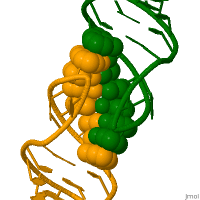Kissing stem-loop on:
[Wikipedia]
[Google]
[Amazon]
 In genetics, a kissing stem-loop, or kissing stem loop interaction, is formed in
In genetics, a kissing stem-loop, or kissing stem loop interaction, is formed in
 In genetics, a kissing stem-loop, or kissing stem loop interaction, is formed in
In genetics, a kissing stem-loop, or kissing stem loop interaction, is formed in ribonucleic acid
Ribonucleic acid (RNA) is a polymeric molecule that is essential for most biological functions, either by performing the function itself (non-coding RNA) or by forming a template for the production of proteins ( messenger RNA). RNA and deoxyr ...
(RNA) when two bases between two hairpin loops pair. These intra- and intermolecular kissing interactions are important in forming the tertiary
Tertiary (from Latin, meaning 'third' or 'of the third degree/order..') may refer to:
* Tertiary period, an obsolete geologic period spanning from 66 to 2.6 million years ago
* Tertiary (chemistry), a term describing bonding patterns in organic ch ...
or quaternary structure of many RNAs.
RNA kissing interactions, also called loop-loop pseudoknots, occur when the unpaired nucleotide
Nucleotides are Organic compound, organic molecules composed of a nitrogenous base, a pentose sugar and a phosphate. They serve as monomeric units of the nucleic acid polymers – deoxyribonucleic acid (DNA) and ribonucleic acid (RNA), both o ...
s in one hairpin loop, base pair
A base pair (bp) is a fundamental unit of double-stranded nucleic acids consisting of two nucleobases bound to each other by hydrogen bonds. They form the building blocks of the DNA double helix and contribute to the folded structure of both DNA ...
with the unpaired nucleotides in another hairpin loop. When the hairpin loops are located on separate RNA molecules, their intermolecular interaction is called a kissing complex. These interactions generally form between stem-loops. However, stable complexes have been observed containing only two intermolecular
Watson–Crick base pairs.
Biological significance
RNA molecules perform their function in living cells by adopting specific and highly complex 3-dimensional structures. It is believed that recombination may be initiated by the kissing loops. Recombination is critical to successful evolution, especially in the adaptation and survival of viruses. Furthermore, the kissing complex is composed of two hairpin loops that function as a regulator of CoLE1 plasmid in the E.Coli bacteria. This regulation happens when the antisense RNA of E.Coli and RNA primer responsible for DNA replication hybridizes to form the kissing complex.In retroviruses
Retroviruses are viruses that are very similar in structure, which allows them to silently replicate inside a host, keeping it alive until the replication is completed and the host is no longer needed. The genomic RNA of retroviruses is linked non-covalently to the dimer linkage structure (DLS), a non-coding region in the 5' UTR. For the kissing loop interaction to occur, there is a triple interaction that involves a 5'-flanking purine and 2 centralized bases in the complementary strand. This interaction transcripts in the major groove of the kissing loop dimer. The human immunodeficiency virus ( HIV) is a retrovirus that can be transmitted via the interactions of bodily fluids. There are two types of HIV viruses, human immunodeficiency virus type 1 ( HIV-1) and human immunodeficiency virus type 2 ( HIV-2). From the two types of the Human Immunodeficiency Virus strain, HIV-1 is the most common strain. The RNA of the HIV-1 virus uses the kissing stem loop interaction as a means of recognition, the main step of interaction of the dimerization initiation site (DIS) to form the duplex. To study the kissing stem-loop loop interaction, It was seen that the Dimerization initiation site (DIS) complex was essential to the replication of the HIV type 1 virus in theeukaryotic
The eukaryotes ( ) constitute the Domain (biology), domain of Eukaryota or Eukarya, organisms whose Cell (biology), cells have a membrane-bound cell nucleus, nucleus. All animals, plants, Fungus, fungi, seaweeds, and many unicellular organisms ...
cell, and any changes to the stem loop structure diminished the dimerization interaction. Experimentally, it has been seen that, in vivo, mutating the Dimerization initiation site (DIS) obstructed the dimerization of the DIS complex.
See also
*Stem-loop
Stem-loops are nucleic acid Biomolecular structure, secondary structural elements which form via intramolecular base pairing in single-stranded DNA or RNA. They are also referred to as hairpins or hairpin loops. A stem-loop occurs when two regi ...
* Pseudoknot
* RNA
Ribonucleic acid (RNA) is a polymeric molecule that is essential for most biological functions, either by performing the function itself (non-coding RNA) or by forming a template for the production of proteins (messenger RNA). RNA and deoxyrib ...
* Nucleic acid tertiary structure
Nucleic acid tertiary structure is the three-dimensional shape of a nucleic acid polymer. RNA and DNA molecules are capable of diverse functions ranging from molecular recognition to catalysis. Such functions require a precise three-dimensiona ...
* Three prime untranslated region
* Adaptation
In biology, adaptation has three related meanings. Firstly, it is the dynamic evolutionary process of natural selection that fits organisms to their environment, enhancing their evolutionary fitness. Secondly, it is a state reached by the p ...
References
Further reading
*External links
* {{Biomolecular structure Cis-regulatory RNA elements Retroviridae